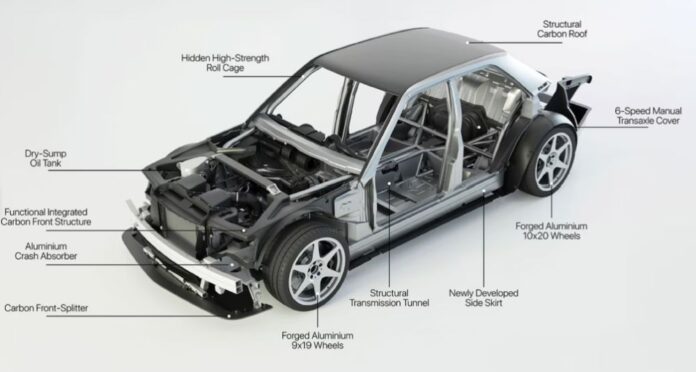In the fall of 2023, HWA announced that it would develop a restomod based on the Mercedes 190 E 2.5-16 Evo2. Now, the German company is giving more details about the unfolding production process of the car that will be sold from the end of 2025 in only 100 units.
HWA, the racing company founded in 1998 by AMG founder Hans Werner Aufrecht, announced in November 2023 that it will develop its own car: a restomod based on the Mercedes 190E 2.5-16 Evo2. Only 100 units will be produced and deliveries will start at the end of 2025. A year before deliveries began, HWA revealed information about the production process.
HWA Evo retains around 25% of the body of 190E
It starts with a Mercedes 190E W201 and disassembles the engine, axles, interior, and electronics. Then, the steel body is checked, cleaned, and reinforced. HWA claims that in the end, they kept about 25% of the original bodywork, especially the center area with the pillars. The new body is reinforced with a tubular steel structure that plays the role of a roll cage, and the roof is made of carbon fiber to achieve a lower center of gravity. The front impact-absorbing aluminum structure at the front is new as is the driveshaft central tunnel structure. The front and rear structures are fitted to the existing bodywork where the front, center, and rear pillars are visible. Finally, the bodywork is painted with a cathodic dip.
The front-end module in the photo below is made of carbon fiber at the top and aluminum and high-alloy steel at the bottom. The engine and the new double wishbone suspension are attached to this. The front and rear modules are then connected to the rest of the bodywork and function as load-bearing components.
The new drive shaft transmits power to the rear wheels in the reinforced cardan tunnel. The gearbox is mounted to the rear axle, and the front axle has been pushed 50 mm further forward to achieve a 50-50% weight distribution. The floor is stapled and flat in the front and side areas to achieve a smoother flow of air under the car.
The front and rear axles feature KW dampers that can be manually adjusted. The HWA Evo is fitted as standard with manually adjusted KW dampers dampers and Brembo brakes with steel discs. Optional KW adaptive dampers electronically adjusted and ceramic disk brakes, also supplied by Brembo, are available. The HWA Evo runs on 19-inch wheels with 245/35 R19 tires up front and 20-inch wheels with 265/35 R20 tires at the rear. The original 1990 Mercedes 190E 2.5-16 Evo 2 had 17-inch wheels.
Due to the fact that only the center area of the body has been retained and the front and rear modules are completely new, the exterior dimensions have changed: the exterior length is 4.58 m instead of 4.43 m, the wheelbase is 2.75 m instead of 2.67 m, and the width is 1.90 m instead of 1.36 m.
Despite of increased dimensions and use of a V6 bi-turbo instead of a 4-cylinder like in the iconic Evo2, the car weights only 1,360 kg.
V6 bi-turbo engine modified by HWA
HWA has not yet released detailed engine data but mentioned that under the hood will be a twin-turbo V6 engine that is modified by HWA. Equipped with dry sump lubrication, the engine is likely to be a 3.0-liter V6 from the Mercedes lineup, which was under the hood of various Mercedes C, E, and S-Class models from 2010 until 2018 when Mercedes switched to the inline-six configuration. HWA’s modified powerplant will deliver 450 PS and 550 Nm to the rear axle via a six-speed manual gearbox and will enable a top speed limited to 270 km/h
Optionally, an Afflaterbach package will be available, like Porsche’s Weissach package, which will boost engine output to 500 PS and give a top speed of 300 km/h.
The Mercedes 190E 2.5-16 Evo2 was only available in blue-black metallic(paint code 199), with only the final two cars finished in silver, but the HWA Evo will be available in a much more diverse palette of colors and finishes.
The interior will have digital instrument cluster instead of the analog ones from the 1990s model but the digital technology will replicate the period feel of LED displays from the early 1990s. Customers can seamlessly integrate their smartphones to take advantage of the EVO’s premium sound system and navigation functionality, or adjust the display to select a digital representation of the analogue dials fitted to the Mercedes-Benz EVO II.
HWA was planning to equip the HWA Evo with Recaro seats, but it’s not known what will happen after Recaro goes bankrupt.
The unit with chassis number 000 was sold at a Sotheby’s auction on July 27, 2024, for 1.31 million euros. The remaining 99 units will be sold for 714,000 euros plus VAT. HWA requires a 30% deposit to reserve the car.

